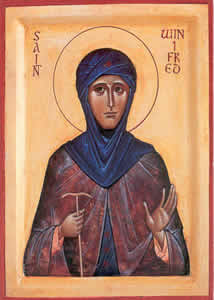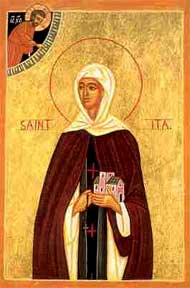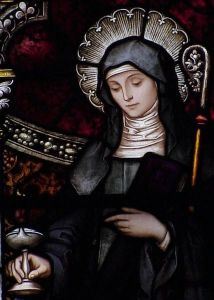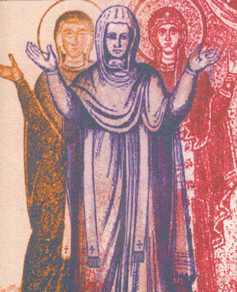Sacred Connections Scotland
Was there a female apostolic succession?
Barry Dunford
A 19th century French researcher, Édouard Schuré, in his work The Great Initiates: A Study of the Secret History of Religions, first published in 1889, writes: “Women have a special place among Jesus’ followers.. Christ is the restorer and liberator of women, whatever Saint Paul and the Church Fathers may have said.. Christ elevates her by restoring her mission of love and divination. The woman initiate represents the soul in mankind.. that is, the power of Intuition, the loving and seeing faculty. The turbulent Mary Magdalene.. became his most ardent disciple. It was she, according to Saint John, who first saw the divine teacher, the spiritual Christ, risen from his tomb. Legend has insisted in seeing in this ardent and believing woman Jesus’ greatest worshipper, the initiate of the heart, and legend is not mistaken, for her story represents the entire regeneration of woman as desired by the Christ.”
The spiritual role of women was also recognised in the pre-Christian Druid tradition. According to the Welsh bard, Edward Jones: “Beside the Druids, the Britons had Druidesses, who assisted in the offices of religion, and shared in the honours and emoluments of the priesthood. The Druidesses of Gaul and Britain are said to have been divided into three ranks, or classes.” (The Bardic Museum of Primitive British Literature, 1802). The Rev. Richard Smiddy also writes: “It appears that females were, at one time, admitted to the order or fraternity of the Druids, and that they were appointed to fill certain offices in connexion with the oracles or suil-bheil. Hence, the name of sibyl or sibylla, of the Latins. A female of this class was called a bean-draoi, that is, ‘a woman Druid’; and by the name was meant a priestess, prophetess, or enchantress.. We have already seen that the suil-beal, that is, the sibyl, or oracle, was an institution of the Druids.. It is stated that some of these oracles, or sibyls, uttered matters in connexion with the life of the future Redeemer.” (An Essay on the Druids, the Ancient Churches and the Round Towers of Ireland, 1871). Interestingly, Dr. John A. Goodchild notes: “I have been working hard.. at various old puzzles relating to the Mother-Church at Glaston.. I am pretty clear of this, that from the establishment of that Church before the middle of the 1st century, a woman, always a Princess of the Royal Blood, was its Supreme Head and Nursing Mother, until she laid down her authority about the middle of the 6th century at an Irish Church Congress held under the presidency of Comgal of Bangor.” (Ref. The Avalonians by Patrick Benham, 1993)
The canonical gospels of the New Testament record the presence of a number of women disciples around Jesus, especially Mary Magdalene. Could there have been a female apostolic succession which ostensibly has gone unrecorded in the official history books? In the Christian Gnostic texts Mary Magdalene is referred to as “the apostle to the apostles” and in France (ancient Celtic Gaul) she is known as the “apostle of Provence”. There is also a tradition of another female disciple of Jesus called Lourda who founded Lourdes in France. Looking at the possible role of female Christian initiates within the Church of Christ, in some instances they may have been ordained under the title of Deaconess. Moreover, the Celtic female saints were often associated with holy wells and springs which could suggest a continuity with the pre-Christian Annat tradition relating to the mother Goddess Anaitis who may have been associated with lunar worship. In the ancient Pagan era the moon held priority to the sun in celtic devotion. In fact, the celtic calendar is lunar based. Interestingly, the gaelic celts saw the moon as masculine and the sun as feminine.
Examples of female Celtic Saints:
St. Etheldreda, a 7th century British saint, daughter of a British King. Married a King of Northumbria. Later became an Abbess founding a monastery at Ely in East Anglia on the site of the present cathedral.
St. Winifred (Gwenfrewi in welsh meaning radiant freda). Gwen can mean white, shining or holy. She was a niece of St. Beuno (6th century) who claimed descent from a relative of the Holy Family of Jesus. She was renowned for her healing well at Holywell in North Wales. On the seal of the cathedral chapter of St. Asaph, in Wales, she appears as an Abbess bearing a crozier which was a symbol of leadership and authority.
St. Ita (Ytha). Born in 480 A. D of noble descent in County Waterford, Ireland. She founded a monastic settlement at Killeedy (Cill Ide). She is said to have died in 570 A.D. and was known as “the foster mother of the saints of Ireland”, because she was a mother figure to several of Ireland’s early saints, including St. Brendan. Her symbol was a cross with a heart at the centre of a small labyrinth.
St. Hilda (614-680 A. D). She was the niece of King Edwin of Northumbria. She studied the traditions of Celtic monasticism which St. Aiden brought from Iona. St. Aiden later appointed St. Hilda as an Abbess and she founded a monastery at Whitby in north Yorkshire. Archeological evidence shows that her monastery was in the celtic style with its members living in small houses for two or three people. She gained such a reputation for wisdom that kings and princes sought her advice.
St. Bega. A 7th century saint who came from County Down in Ireland to north Britain and apparently founded a small female religious community inspired by St. Aiden. Placenames link St. Bega with Cumbria, northern England, and the Scottish borders. She also associated with St. Hilda and St. Etheldreda.
St. Brigid or Brigit (453-523 A. D) who founded a monastery for both monks and nuns at Kildare in Ireland. She is said to be buried at Downpatrick together with St. Patrick and St. Columba, which clearly shows that St. Brigid was highly venerated in the early Celtic Church. It has been suggested that Kildare may have been the site of an earlier Druid seat of learning.

St. Winifred

St. Ita

St. Brigid
Like their male counterparts, all of these female saints were of royal and noble descent. Could they have been initiates of a Johannine Celtic Church? It may be of interest to note that traditionally St. John, together with Mary, the mother of Jesus, and Mary Magdalene, was at Ephesus in Anatolia, Asia Minor, where there was a major mystery temple dedicated to Artemis, a moon goddess, whom the Greeks also called Diana. This Temple was one of the seven wonders of the ancient world.
The Johannine mystery tradition may have incorporated an initiatic tradition which could have included women as well as men.
Women Deacons in the early Christian Church
In her Studies in Early Mysticism in the Near and Middle East (1931), Margaret Smith writes: “Asceticism and the monastic life found almost as many adherents among the women of the early Christian Church as among the men.. Women held a high position in the early Christian Church; we note that St. Paul salutes fifteen women alongside of eighteen men. Women exercised the prophetic office, and Priscilla, whose name is twice mentioned before that of her husband by St. Paul, as if she held a more prominent position in the Church, was evidently a missionary and teacher of distinction, and it has been suggested, with some reason, that she was the writer of the Epistle to the Hebrews. The order of deaconesses (ministræ) is mentioned by Pliny, and there appears to have been an order of regular female ascetics, who formed an important part of the organisation of the Church in the first three centuries, and had their names enrolled on the list of church officials.. The Acts of Paul and Thekla, written about A. D. 179, which appear to contain some genuine information about St. Paul, gives a prominent role to women, as prophetesses, and above all to the ‘apostle’ Thekla of Iconium, who is said to have baptised, and to have enlightened many with the word of God.. Origen had a number of women pupils.. Up to the end of the second century or later, women appear to have been prominent in the Christian Church as deaconesses, prophetesses, teachers and missionaries.. Women seem, indeed, to have been in the majority, at least among the upper classes, in the early Christian Church, and in the persecution of Licinius, about A. D. 322, special prohibitions were directed against women, as if the emperor realised that the strength of Christianity lay in its women members.”
Regarding the female ‘apostle’ Thecla, in her work The Lost Apostle (2006) Rena Pederson writes: “There are multiple examples of art honoring Thecla in Egypt.. In Rome, scholars found a sarcophagus with a relief showing Paul and Thecla traveling together in a boat.. A catacomb of St. Thecla can be found on the Via Ostiensis, not far from the burial place of St. Paul, and is mentioned in the seventh-century itineraries to the graves of the Roman martyrs. Santa Thecla also is the patron saint of Tarragona, Spain, and there are Iberian wall designs from the first century showing Paul preaching to Thecla.. There appear to have been attempts to obscure Thecla’s role in later years.. One of the foremost Jesus scholars in the United States, John Dominic Crossan, of DePaul University, and Jonathan L. Reed, a leading authority on first-century Palestinian archaeology, recently brought to light an attempt to suppress the Thecla story. In their book In Search of Paul, Crossan and Reed tell of a cave that was discovered around 1906, high above the ruins of Ephesus. Just to the right of the entrance are two sixth-century images of St. Thecla and St. Paul. Both are the same height, an iconographic sign that they are of equal importance. Both have their right hands raised in a blessing gesture, again an iconographic sign that they are of equal authority. While the image of Paul was left untouched over the centuries, someone later scratched out the eyes and upraised fingers of the Thecla figure, erasing her blessing gesture.. If both figures had been disfigured, Crossan and Reed point out, it could be chalked up as a random act of vandalism. But it was only the Thecla figure that was defaced. Paul remains as an authority figure. The woman is blinded and silenced. Crossan and Reed observe that ‘even the cave’s present name, ‘St. Paul’s Grotto,’ continues the negation of female-male equality once depicted on the walls’.”
During the early centuries A. D. the Celtic Church in the west tended to follow the traditional mode of worship of the Eastern Church (rather than the Roman Church). We find that St. Paul’s letters mention a number of Christian women in the ministry by name and this was clearly the case with the Celtic Christian Church in Britain. St. Clement of Alexandria (150-215) testifies to women deacons, ascribing tasks to them that would still be entrusted to ordain women deacons centuries later: “The apostles, giving themselves without respite to the work of evangelism as befitted their ministry, took with them women, not as wives but as sisters, so that they might serve as their co-ministers, serving women living at home: by their agency the teaching of the Lord reached the women’s quarters without arousing suspicion. We are also aware of all the things Paul prescribed on the subject of women deacons in one of the two letters to Timothy.”
In the 2nd and 3rd centuries women continued to be involved in the apostolate. The Didascalia Apostolorum (c. 250 A. D), a pastoral handbook, urges Bishops to ordain men and women deacons. The Council of Nicea (325 A. D) witnessed to the existence of women deacons. The Greek Fathers of the 3rd, 4th and 5th centuries mention women deacons. The Apostolic Constitutions (380 A. D), another collection of pastoral directives, repeated the instructions on women deacons already found in the Didascalia. It also preserved the oldest known ordination rite for women deacons.
A 4th century tombstone in Jerusalem commemorates a deacon called Sophia. The Greek text reads “Here lies the servant and bride of Christ, Sophia, the (woman) deacon.” In Cicilia, in modern Turkey, five tombs honouring the memory of women deacons have been found. In Jerusalem, four women deacons are recorded on tombstones and another four elsewhere in Palestine. The ancient calendar of saints for the Greek-Byzantine part of the church fixed feast days for 26 women deacons. They provide evidence for the impact women deacons had upon their local church communities. In Gaul (ancient France) we find women deacons such as St. Radegunde and St. Genevieve, the patron saint of Paris.
Some women deacons were nuns at the same time, often superiors of convents so that they could attend to the spiritual needs of their sisters. This may explain how in the West traces of the diaconate ordination were retained in the installation of prioresses and abbesses of some orders of women. The laws of Justinian more than once mention the men and women under the heading “men and women deacons”. The Didascalia of the apostles (c. 250 A. D) was a pastoral handbook for bishops, presented as instructions left by the apostles. Originally composed in Greek it was translated into Syriac, Arabic and Latin. (Interestingly, in the Latin which is the only version available for this text, the term ‘Diaconissa’ appears.) This apostolic pastoral handbook states: “We assert that the ministry of a woman deacon is especially required and urgent. For our Lord and Saviour was himself served by women deacons, such as Mary Magdalene, Mary, the daughter of James and mother of Joseph, and the mother of the sons of Zebedee, along with still other women.” The original Greek word for deacon meant “servant” and it was used as a term for both men and women. In Christian communities it indicated a special ministry to which persons were assigned by ordination.
As an interesting aside, the Rev. William Lee Ker, in his book Mother Lodge Kilwinning: the Ancient Lodge of Scotland, published in 1896, says that: “The Grand Deacons of Mother Kilwinning from 1642 to 1732 were to all intents and purposes the Grand Masters.” We know that Kilwinning was at one time the site of a Culdee Community. Could the use of the term Deacon in this instance imply a possible continuity from the Culdee Christian Order to Scottish Freemasonry?

St. Mary mosaic, San Venanzio
Finally, there is an interesting mosaic in the oratory of San Venanzio in Rome dated 642 A. D. which was made under Popes John IV and Theodorus, both Greeks by birth. The image shows Mary, Mother of Jesus, praying with her hands outstretched, apparently with two haloed female companions. Her main dress is a tunic. Her veil is part of the mantle. It covers her head and her upper body and flows down all the way to just above her ankles, revealing a tunic in front. Coming down from underneath her veil, but over the tunic, we can see a bishop’s pallium marked with a cross. Women deacons wore their stole in the same way, but in their case two extremities would hang in front. (Ref. No Women in Holy Order? The Women Deacons of the Early Church by John Wijngaards, 2002)
Could there have been a female apostolic succession from Mary, the mother of Jesus, just as there was a male apostolic succession ordained by her son? Could this perhaps have been written out of the ostensible historical records by male scribes acting under the instruction and supervision of a patriarchally dominated church? With the information to hand at present we can but speculate and wonder. We should also remember that a number of celtic royal saints, both male and female, claimed genealogical descent from the family of the Mother of Christ. This might also reinforce the notion of a possible hereditary right of succession. Hereditary succession was central to the Culdee communities and fifteen unbroken generations have been listed at Armagh, the ecclesiastical primacy of the Celtic church in Ireland. It is possible that a female apostolic succession could have been founded on a family and hereditary basis from women who were directly related to the Holy Family of Christ.